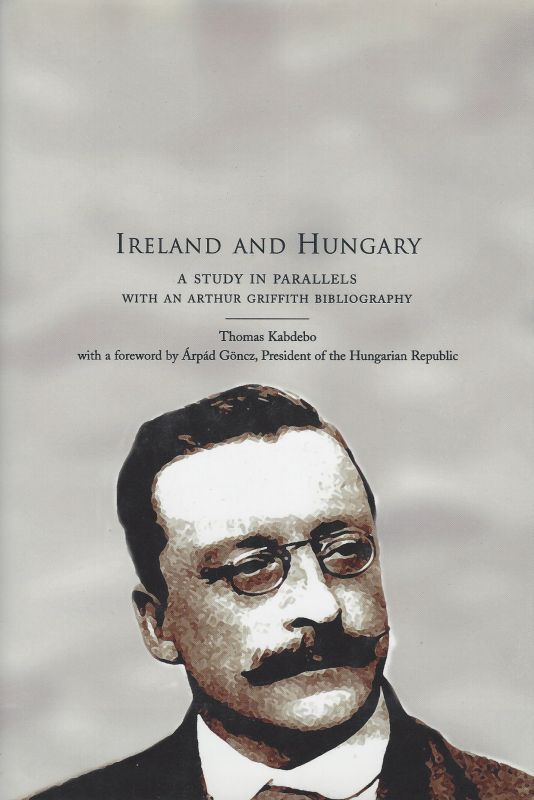[Griffith, Ireland and Hungary.
Ireland and Hungary. A study in parallels. With an Arthur Griffith bibliography. With a foreword by Árpád Göncz, President of the Hungarian Republic.
Dublin, Four Courts Press, 2001. 25 cm. 122 pages. Original Hardcover with original dustjacket in protective collector’s mylar. Excellent condition with only minor signs of external wear.
It was Griffith’s “The Resurrection of Hungary” that first noted historical similarities and spiritual affinities between the two countries at opposite littorals of Europe, but the historical accuracy of his work has often been questioned.
William O’Reilly wrote in his Review of Kabdebo’s overdue publication that while Kabdebo’s book is not the first “to put Ireland on the scales, balancing her Western European historical Development with the Magyar one in Central Europe, his is the most comprehensive”.
Arthur Joseph Griffith (Irish: Art Seosamh Ó Gríobhtha; 31 March 1871 – 12 August 1922) was an Irish writer, newspaper editor and politician who founded the political party Sinn Féin. He led the Irish delegation at the negotiations that produced the 1921 Anglo-Irish Treaty, and served as President of Dáil Éireann from January 1922 until his death in August 1922.
After a short spell in South Africa, Griffith founded and edited the Irish nationalist newspaper The United Irishman in 1899. In 1904, he wrote The Resurrection of Hungary: A Parallel for Ireland, which advocated the withdrawal of Irish members from the Parliament of the United Kingdom and the setting up of the institutions of government at home in Ireland, a policy that became known as Sinn Féin (ourselves). On 28 November 1905, he presented “The Sinn Féin Policy” at the first annual convention of his organisation, the National Council; the occasion is marked as the founding date of the Sinn Féin party. Griffith took over as president of Sinn Féin in 1911, but at that time the organisation was still small.
Griffith was arrested following the Easter Rising of 1916, despite not having taken any part in it. On his release, he worked to build up Sinn Féin, which won a string of by-election victories. At the party’s Ardfheis (annual convention) in October 1917, Sinn Féin became an unambiguously republican party, and Griffith resigned the presidency in favour of the 1916 leader Éamon de Valera, becoming vice-president instead. Griffith was elected as an MP for East Cavan in a by-election in June 1918, and re-elected in the 1918 general election, when Sinn Féin won a huge electoral victory over the Irish Parliamentary Party and, refusing to take their seats at Westminster, set up their own constituent assembly, Dáil Éireann.
In the Dáil, Griffith served as Minister for Home Affairs from 1919 to 1921, and Minister for Foreign Affairs from 1921 to 1922. In September 1921, he was appointed chairman of the Irish delegation to negotiate a treaty with the British government. After months of negotiations, he and the other four delegates signed the Anglo-Irish Treaty, which created the Irish Free State, but not as a republic. This led to a split in the Dáil. After the Treaty was narrowly approved by the Dáil, de Valera resigned as president and Griffith was elected in his place. The split led to the Irish Civil War. Griffith died suddenly in August 1922, two months after the outbreak of that war. (Wikipedia)
- Keywords: 19th Century · 19th Century – Rare · Bibliography · Bibliography Rare · Catalogue Irish History Six – General Irish History · Catalogue Irish History Three – From Famine to Free State · Collection Tadhg Ó Murchú (This is a book from his personal reference library) · Contributions in history · From the library of Tadgh Ó Murchu · Great Britain · Hungary · Ireland · Irish History – Rare · Irish-Hungarian Relations · Politics and government · Relations
- Language: English
- ISBN: 185182605X
- Inventory Number: 100573AB
EUR 68,--
© 2025 Inanna Rare Books Ltd. | Powered by HESCOM-Software










